In the month of September, Video Days plays the sucker for women who lure us into a world of danger.
THE GRIFTERS (1990) proceeds as if the filmmakers assumed the best way to keep viewers guessing is if they kept themselves guessing, over what type of film they wanted to make, who would be best cast, and how the characters might relate. Centered on sharpies and frauds, this whimsically violent crime drama looks and feels like what it is–remarakbly cheap–but unlike its characters, the writing and directing are unable to make a ten dollar bill look like twenty. While the climax packs a punch, nothing that proceeds it is dialed in with that degree of attention.
Jim Thompson was born in Anadarko, Oklahoma in 1906 in an apartment above the Caddo County Jail. His father “Big” Jim, a schoolteacher, had been elected county sheriff on a promise to rid the territory of thugs and gamblers, but two years into his term, was removed from office on the accusation of embezzlement. Sending his wife and two children to the town of Burwell, Nebraska, “Big” Jim, according to legend, fled to Mexico on horseback. He’d summon the family to Fort Worth, Texas, where the younger Jim grew up. Thompson would spend two years in the employ of the Hotel Texas and as a bellhop and several more roughnecking in the oil patch of West Texas. What he really wanted to do as early as a teenager was to be a writer. Taking the advice of an editor at Texas Monthly, Thompson applied to college and in 1929, was accepted to the University of Nebraska (he’d later quip, “Hell, in case you’re interested, is the College of Agriculture at the University of Nebraska. You can take my word for it.”). The college quarterly literary journal, the Prairie Schooner, published a few of Thompson’s short stories, but he dropped out of school after two years, marrying a local telephone operator. Thomspon returned to Oklahoma and found work with the Federal Writers’ Project, contributing to state guidebooks.
Thompson’s break came on a trip to New York, where folk singer Woody Guthrie was taken enough with Thompson’s work-in-progress to get him through the door of Modern Age Books, where the author compelled the publisher to set him up with a typewriter, paper and $15/week to complete a novel, the semi-autobiographical Now and On Earth, published as a mass market paperback in 1942. Thompson’s first crime thriller, Nothing More Than Murder, came in 1948 by Harper. Between 1952-1957, the author published fifteen novels, including The Killer Inside Me and After Dark My Sweet, all paperbacks a rung or two below what was considered literary. Some of Thompson’s novels would be sped through the typewriter over a weekend in order for him to pay bills the following week. None flew off newsstands. His worldview was bleak, with characters who wrestled with good and evil, the latter usually triumphing. One of Thompson’s fans was a young filmmaker from New York named Stanley Kubrick, who with his producer James B. Harris had hammered out a structure for Kubrick’s sophomore film, based on a crime novel by Lionel White titled Clean Break. An admirer of The Killer Inside Me, Kubrick commissioned Thompson to infuse their script with the tough, street smart dialogue of Thompson’s books. Released as The Killing (1956), Thompson was thrown an undignified “dialogue by” screen credit for his work, but needing a job, moved to Los Angeles to punch up dialogue for Kubrick’s next film, based on the Humphrey Cobb World War I novel Paths of Glory (1957).
Thompson took some television work, writing four episodes of the western series Mackenzie’s Raiders in 1958-1959. More novels followed, including The Grifters in 1963. Though a professional writer, Thompson was also a lifelong drinker and smoker, and after suffering several strokes in his sixties, died in 1977 in L.A. At the time of Thompson’s funeral, none of his twenty-nine books were in print. That changed when novelist Barry Gifford noticed a stack aging in a Paris bookstore, Jim Thompson among other forgotten hardboiled American authors of the 1930s, ‘40s and ‘50s. In 1984, Gifford and publisher Don Ellis co-founded Black Lizard Books in San Francisco. With lurid artwork by local illustrator Jim Kirwan, Black Lizard’s curated pulp fiction would start to attract the attention of Hollywood, from producers to actors, Sean Penn calling The Killer Inside Me the best novel he’d read up to that time. By 1988, film rights to half of Black Lizard’s forty-three titles had been optioned and several would be produced, hitting theaters at virtually the same time:
Miami Blues by Charles Willeford arrived as a movie in the spring of 1990, with Alec Baldwin, Fred Ward and Jennifer Jason Leigh in the cast. An adaptation of Jim Thompson’s After Dark, My Sweet directed by James Foley and starring Rachel Ward, Jason Patric and Bruce Dern premiered in late summer (film critic Gene Siskel would rank it #2 on his list of the year’s ten best films). Hell Hath No Fury by Charles Williams was made into a sultry noir starring Don Johnson, Virginia Madsen and Jennifer Connelly under its less controversial title, The Hot Spot, directed by Dennis Hopper and sneaking into theaters in fall 1990. Black Lizard was purchased by Vintage Books, an imprint of Random House, but not before propelling Barry Gifford to the big screen with no less than David Lynch adapting Gifford’s novel Wild At Heart: The Story of Sailor and Lulu, which opened in August 1990. Hollywood wasn’t done with its noir revival yet.
Film preservationist Robert A. Harris had led the restoration of Abel Gance’s silent film Napoleon (1927) for American Zoetrope to exhibit with a live orchestra, and would take on restoring Lawrence of Arabia (1962) for Columbia Pictures and Spartacus (1960) for Universal Pictures, both of which received major theatrical re-releases, in 1989 and 1990. Harris was talking with a friend named Bruce Kawin, a professor of English and film studies at the University of Colorado Boulder. Kawin suggested that if Harris and his producing partner Jim Painten were as interested in making films as restoring them, they should take a look at the novels of Jim Thompson that Black Lizard had restored to print. Harris and Painten both liked The Grifters, a tragedy involving a salesman in L.A. named Roy Dillon who leads a double life as a short-con artist. Roy’s simple life is complicated by the reappearance of his estranged mother Lilly, who works for a bookmaker laying bets on long shot horse races in order to mitigate the odds. While Lilly begs Roy to give up the grift, his flame Moira, who reveals herself to be a long-con artist, wants her lover to come in with her on a score. No one trusts anyone.
Harris and Painten took The Grifters to film preservationist and director Martin Scorsese, who Harris would work with on the restoration of Lawrence of Arabia along with Steven Spielberg. While The Grifters didn’t bite Scorsese enough to direct, he did agree to come aboard the project as a producer and help Harris and Painten get it made. Needing a director, Harris polled Tom Luddy– co-founder of the Telluride Film Festival and producer of Mishima (1983) and Barfly (1987)--for suggestions. Luddy recommended Stephen Frears, a veteran of the Royal Court Theatre in the sixties, who’d graduated to directing films for British television in the seventies and by the eighties, directing very well-received feature films in England: The Hit (1984), My Beautiful Laundrette (1985), Prick Up Your Ears (1987). Frears was in France directing his first picture with an American cast and money, an adaptation of the hit stage play Dangerous Liaisons (1988) and didn’t have another job lined up when Scorsese called him. Frears wasn’t familiar with Jim Thompson, but reading The Grifters, was taken with its stylish prose and taut dialogue, as well as its emotional quality, which Frears likened to pulp fiction meets Greek tragedy.
Unfamiliar with screenwriters who’d do service to adapting this material, Frears was at the Telluride Film Festival and mentioned his boggle to director Volker Schlöndorff. The German suggested an American mystery author he’d gotten along with terrifically on two unproduced scripts: an adaptation of the 1959 spy novel Passage of Arms by Eric Ambler and a faithful telling of the Dashiell Hammett novel Red Harvest, which Akira Kurosawa had reset in feudal Japan as Yojimbo (1961). The author was Donald Westlake. Growing up in Albany, New York, Westlake determined upon his discharge from the U.S. Air Force that he wanted to be a professional writer. By the age of twenty-six, he’d published several soft-porn titles under the name “Alan Marshall” before settling into the crime genre in 1960 with a novel he was proud enough to use his given name on, The Cutie, published as The Mercenaries. Westlake didn’t feel his innate sense of humor—on exhibit in his capers featuring master thief John Archibald Dortmunder, who Robert Redford would play in a film version of The Hot Rock (1972)—had a home in the thriller genre. Operating under the pseudonym “Richard Stark,” Westlake cranked out sixteen novels featuring cold-blooded heist man Parker, beginning in 1963. Over the years, leading men including Lee Marvin (Point Blank, 1967), Jim Brown (The Split, 1968) and Robert Duvall (The Outfit, 1973) would mow down Parker’s enemies on film and after a twenty-three year retirement, Stark would return with eight new Parker novels in 1997.
Westlake had sold his skills to Hollywood and it was his work rewriting the horror thriller The Stepfather (1987) that convinced Frears that Westlake could channel the darkness of Jim Thompson to film. According to Westlake, he was offered the commission to adapt The Grifters, reread the novel and turned the job down, finding Thompson’s text too bleak for his taste. Frears phoned the screenwriter from France in the spring of 1988 to tell Westlake he was reading the material wrong, that rather than a tale about a young man on the make, it was a story of survival with his mother Lilly at its center. Westlake agreed to meet with Frears in New York and got along so well, the pair traveled to Los Angeles for a scouting tour. Westlake penned a first draft, which the director didn’t cotton to. Frears, making his first picture in the States, didn’t have much interest in directing a film that was explicitly noir or could be easily categorized and dismissed as such. Westlake wrote each of his scenes on a notecard and asked the director to select the ones he liked. This gave him a map to adapt the sort of film Frears did want to make. Westlake noted that updating Jim Thompson from the sixties to the nineties was relatively easy since the characters didn’t involve themselves in much taking place in the outside world. Westlake simply had to take the hats off the men.
A subtraction Westlake made to Thompson’s novel was the character of Carol Roberg, a survivor of the Dachau concentration camp who as the nurse Lilly hires to rehabilitate her son, Roy seduces. With no contemporary parallel for the German concentration camps, Westlake made the nurse a garden variety minor character. Intrigued by casting an actor young enough to be mistaken for Roy’s sister instead of a mother, Frears wanted Melanie Griffith to play Lilly. Expecting the birth of a daughter–Dakota–in the fall of 1989 with her ex-husband/ new husband Don Johnson, Griffith took her name out of the running in order to spend more time with family. Frears considered a long list of alternatives including Cher before he got down to Anjelica Huston. An Academy Award winner for Best Supporting Actress in Prizzi’s Honor (1985), Huston was in New York working for Woody Allen on Crimes and Misdemeanors (1989). She balked at playing Lilly, while Frears wasn’t convinced she was right, Huston such a lady it was difficult for him to imagine her as a sleazy crook. Without arriving on a viable alternative, Frears and Scorsese met with Huston at the Chateau Marmont in Los Angeles several months later and by this time, the actor, with strongly worded urging from her agent Sue Mengers, reconsidered the part. To conduct research, Huston visited the Bicycle Club in Bell Gardens and the now defunct Horseshoe Club in Gardena to watch the women card dealers at work.
According to John Cusack, he’d scooped up a copy of The Grifters when Black Lizard reprinted it in the mid-eighties and had wanted to play Roy since. The actor campaigned Frears and Scorsese for the role. Another recent Oscar winner for Best Supporting Actress, Geena Davis, spent some time penciled for the role of Roy’s dame Moira (renamed Myra) Langtry. When other offers took Davis off the market, Frears considered an actor he’d offered a very small role in Dangerous Liaisons, the part of the courtesan Emilie whose backside Valmont uses as a desk for one of his letters. The actor was Annette Bening, who’d turned the role down to play the lead, the Marquise de Merteuil, in a rival production, Valmont (1989), to be directed by Miloš Forman. The Grifters would be Bening’s third movie, and her film work was so scarce that Tom Luddy, acting as a middleman for the producers, reached out to Forman to see if they could get a look at Bening’s dailies, which the director was happy to provide. Frears told Bening to watch Gloria Grahame, who’d played the femme fatale in Crossfire (1947). Bening would play Grahame in a future movie–Film Stars Don’t Die In Liverpool (2017) — which took place during the actor’s twilight years, living and working in London. Character actors Pat Hingle, J.T. Walsh, Henry Jones, Gailard Sartain, Stephen Tobolowsky, Eddie Jones, Xander Berkeley, Jeff Perry and Jonathan Gries rounded out the cast.
Martin Scorsese’s involvement landed financing from Cineplex Odeon Films, the motion picture finance arm of the second largest theater chain in North America. In addition to expanding aggressively in the U.S. with what would be 1,700 screens in 415 theaters by November 1990, Cineplex Odeon had branched into film production, bankrolling or helping bankroll small pictures the major studios wouldn’t, even with the talent involved, like a film version of Tennessee Williams’ The Glass Menagerie (1987) directed by Paul Newman, Martin Scorsese’s passion project The Last Temptation of Christ (1988) and an adaptation of Eric Bogosian’s play Talk Radio (1988) starring Bogosian and directed by Oliver Stone. Cineplex Odeon agreed to put up a budget of $8 million for The Grifters in exchange for worldwide distribution rights. Shooting commenced in October 1989 in Los Angeles. The jewelry store where Myra tries to charm the jeweler played by Stephen Tobolowsky is on Hollywood Boulevard near Wilcox Avenue in Hollywood. Roy’s Beaux Arts apartment building also played itself, the ten-story Bryson Apartment Hotel, built in 1913 in the Wilshire District. The bus station where Roy meets his mentor Mintz (Eddie Jones) was filmed at the Saugus Train Depot in Santa Clarita. The shady roadside inn where Lilly and Myra face off is the Sierra Pelona Motel, northeast of Santa Clarita. Ironically, none of the horse track scenes–scripted as being in La Jolla–could be filmed in California, where racing season had ended. Turf Paradise in Phoenix, Arizona would stand in for the track. The exterior of Phoenix City Hall doubled as the morgue Roy is escorted to by the homicide police played by Xander Berekley.
Massive debt and limited access to credit led Cineplex Odeon to put a couple of its pictures awaiting release up for sale. In a co-financing deal with HBO Video, Miramax Films acquired The Grifters for $6 million, as well as the latest Merchant Ivory production, Mr. and Mrs. Bridge (1990) starring Paul Newman and Joanne Woodward. Miramax opened The Grifters in limited release in New York and Los Angeles on December 7, 1990. Newspaper reviews were wholly positive. Gene Siskel & Roger Ebert gave the picture two thumbs up. Siskel acknowledged it was two movies: a confidence scheme and more interesting, a twisted love story between mother and son. Rather than sum anything up, Siskel appreciated how the film simply examined desperate characters living on the fringes of society. Ebert called it a terrific movie that forced the viewer to think, none of the characters doing what they want everyone to think they’re doing. He gave Huston, Cusack and Bening props for turning in Oscar level performances. In his rave for the New York Times, Vincent Canby wrote: “Working from Mr. Westlake’s first-rate screenplay, Mr. Frears has made a gritty, hard-boiled melodrama that is also an examination of the genre. It’s as much about the muddled private lives of these grifters as it is about their professional expertise.” The seedy noir was a seedy noir, and struggled to find an audience, expanding to 766 theaters on January 25, 1991 and spending two weekends among the top ten grossing films in the U.S. The film industry took notice, nominating The Grifters for four Academy Awards: Best Director (Stephen Frears), Best Actress (Anjelica Huston), Best Supporting Actress (Annette Bening) and Best Adapted Screenplay (Donald Westlake). On the same night, the masterpiece Martin Scorsese directed, GoodFellas had six nominations, including Best Picture and Best Director. Scorsese took their losses hard, finding it difficult not to care that movies like GoodFellas or The Grifters were not celebrated in Hollywood.
GoodFellas is full to the brim with memorable characters, a powerful and wonderfully intricate crime story and visual splendor at the service of a specific point of view. The Grifters doesn’t manage very much of that, but it is dealt an ace with Annette Bening, who picks up right where she left off in Valmont, crafting another terrific screen villain. Like Alan Rickman, Bening speaks with elocution whose precision is a pleasure to listen to and puts her at a higher altitude than a lot of her peers (director Rob Reiner and screenwriter Aaron Sorkin exploited Bening’s vocal sorcery as the female lead in their dialogue-driven romantic comedy The American President, 1995). Bening exudes power standing still, and like Rickman, doesn’t (over)act as if she’s playing a villain. As far as her characters are concerned, they’re the heroes. There’s a different movie going on in The Grifters in which Myra is the protagonist, a sophisticated con artist who’s laid the track for a score, until her boyfriend’s mother pays a visit and screws everything up. Myra’s fatal flaw is not arming herself–with a weapon or with knowledge of what she’s walking into. Her character is one that Jim Thompson lacked the experience to write, and that Frears mistakes for a guest star.
If there’s a consistent vision to The Grifters, it’s that its characters went to bed in the 1950s and woke up in 1989, but perhaps in an effort to honor Jim Thompson, all wit is stifled. So is coherence. Given the title and subject matter, we never for a moment buy that Lilly is Roy’s biological mother. The fifteen-year age gap that separates Anjelica Huston and John Cusack accounts for some of that implausibility, but the film never offers up receipts that they are related. The viewer is just told they are, and in a thriller about liars, that claim isn’t worth a damn. Lilly and Roy don’t need to be mother and son for the story to navigate into tragedy, but they do need a bond strong enough to hurt them if severed, and the film doesn’t provide them that connection. It’s equally ridiculous that Roy doesn’t recognize Myra for the operator she is. Myra clearly sees the angles and knows Roy isn’t any more a salesman than she’s a virgin, but he lacks guile when it comes to dealing with her. Ultimately, these are characters who aren’t very good at their work. While Cher or Melanie Griffith would’ve had a field day with Lilly, Anjelica Huston is miscast as a blue collar crook. There’s something about Huston in a cheap motel room that doesn’t seem right, while John Cusack projects such goodness, it's a struggle to believe his character wouldn’t give back any money he stole. While Stephen Frears hadn’t directed a movie that wasn’t made on the down and dirty (including Dangerous Liaisons, rushed to beat Valmont into theaters), The Grifters plays like scenes are missing. The music by Elmer Bernstein (who’d adapt Bernard Herrmann’s score for Scorsese’s reimagining of Cape Fear, 1991) alternates between gothic power and droll goofiness, never matching what’s on screen. What results is a vague movie about sketchy characters rather than a finished movie those characters, and we, deserve.
Video rental category: Mystery/ Suspense
Special interest: Femme Fatale


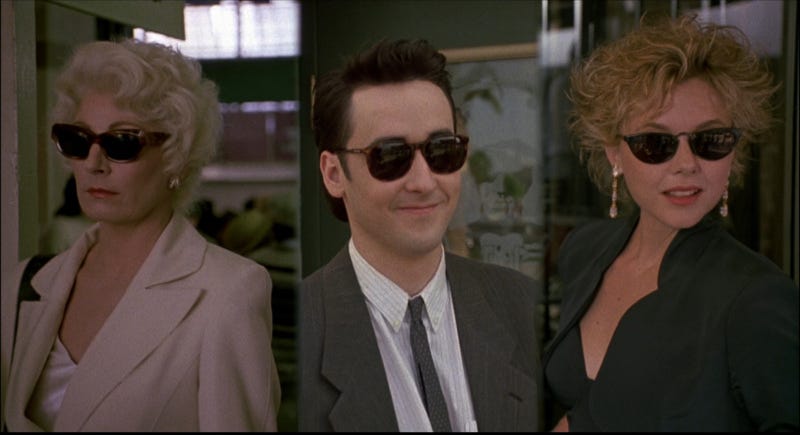

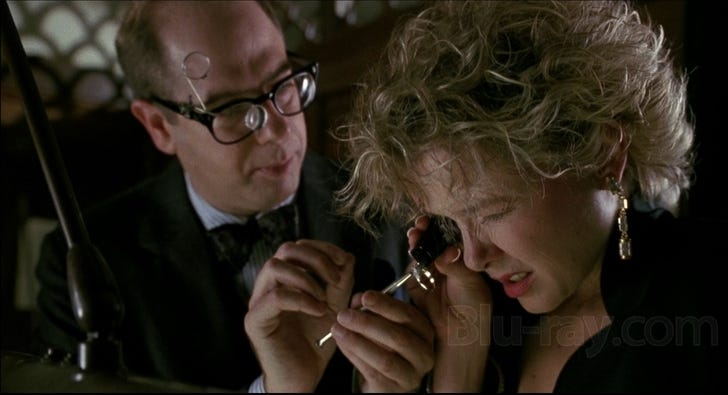
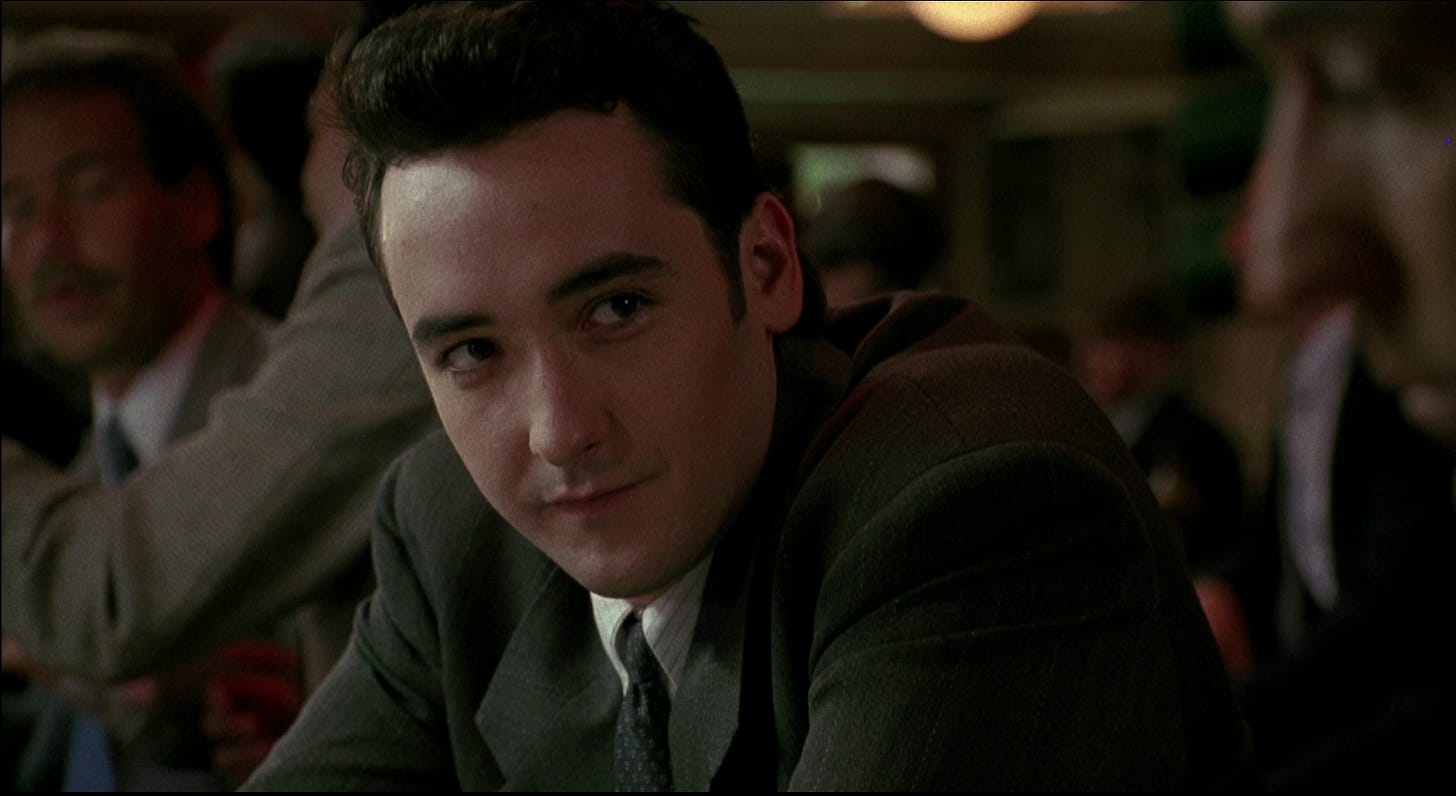
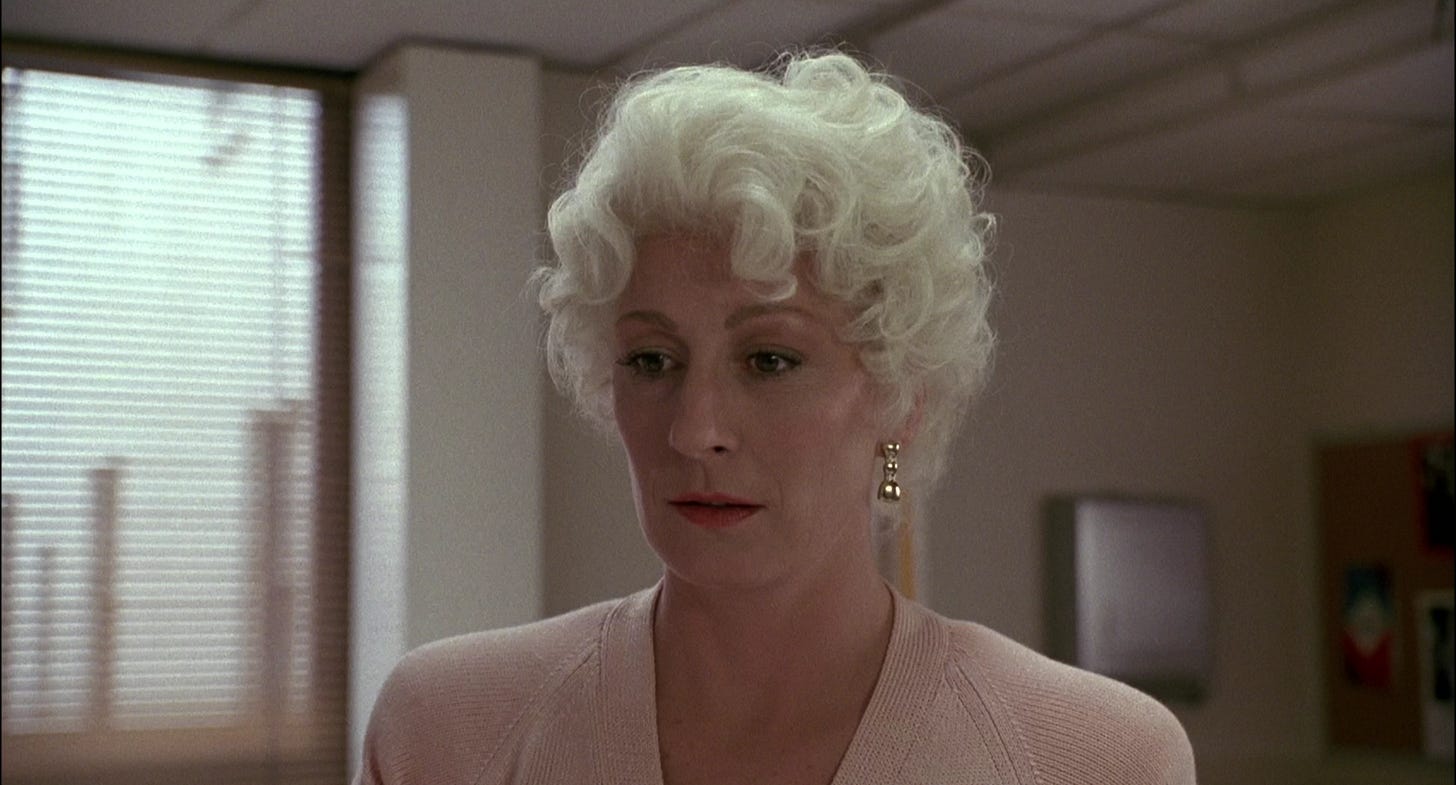
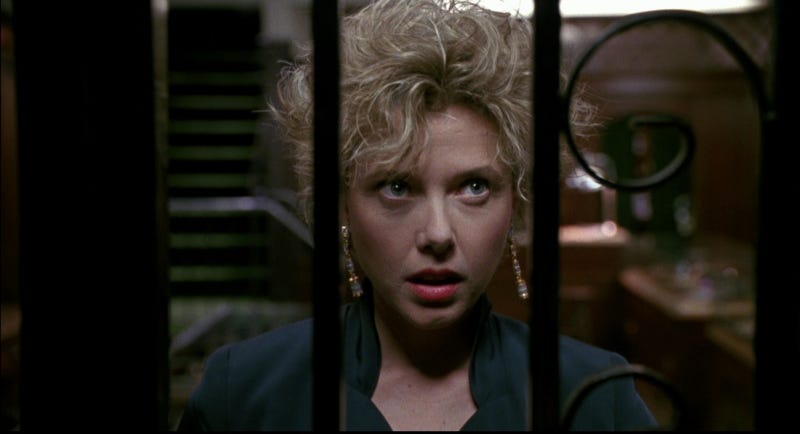
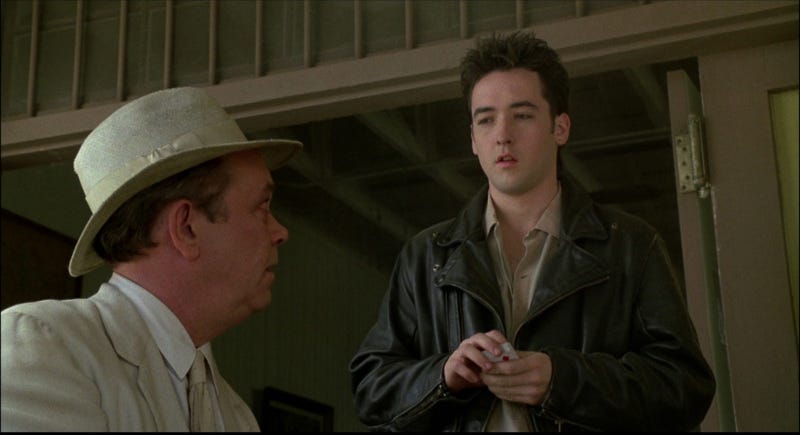
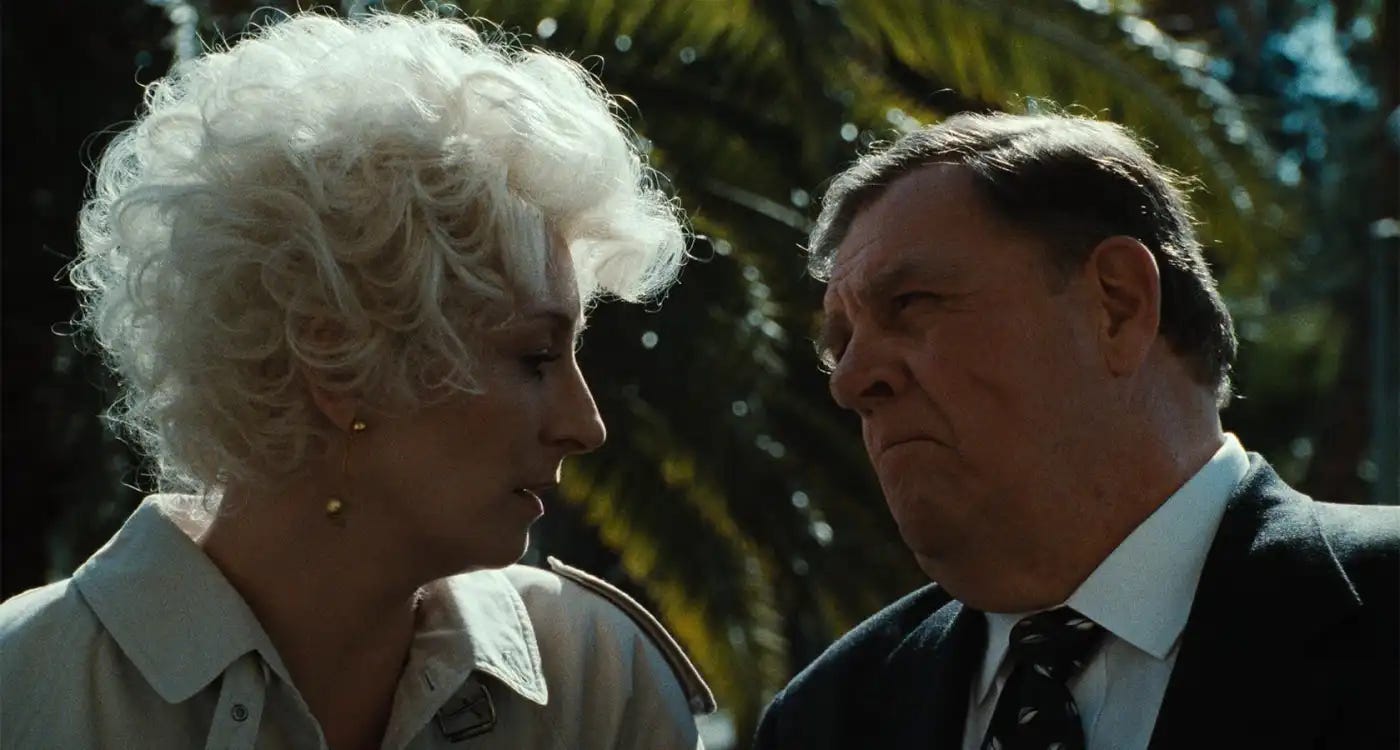
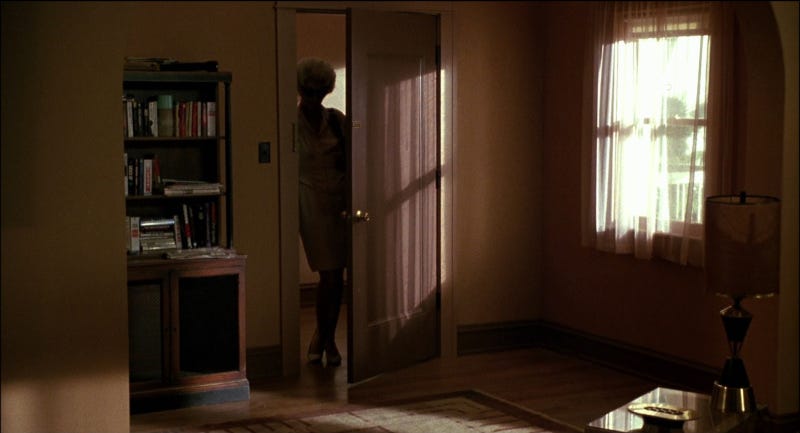
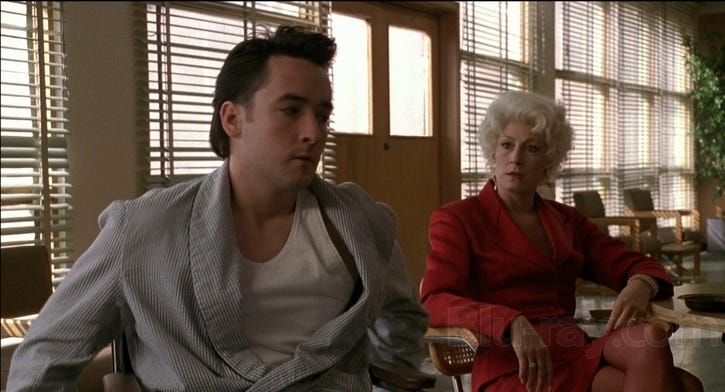
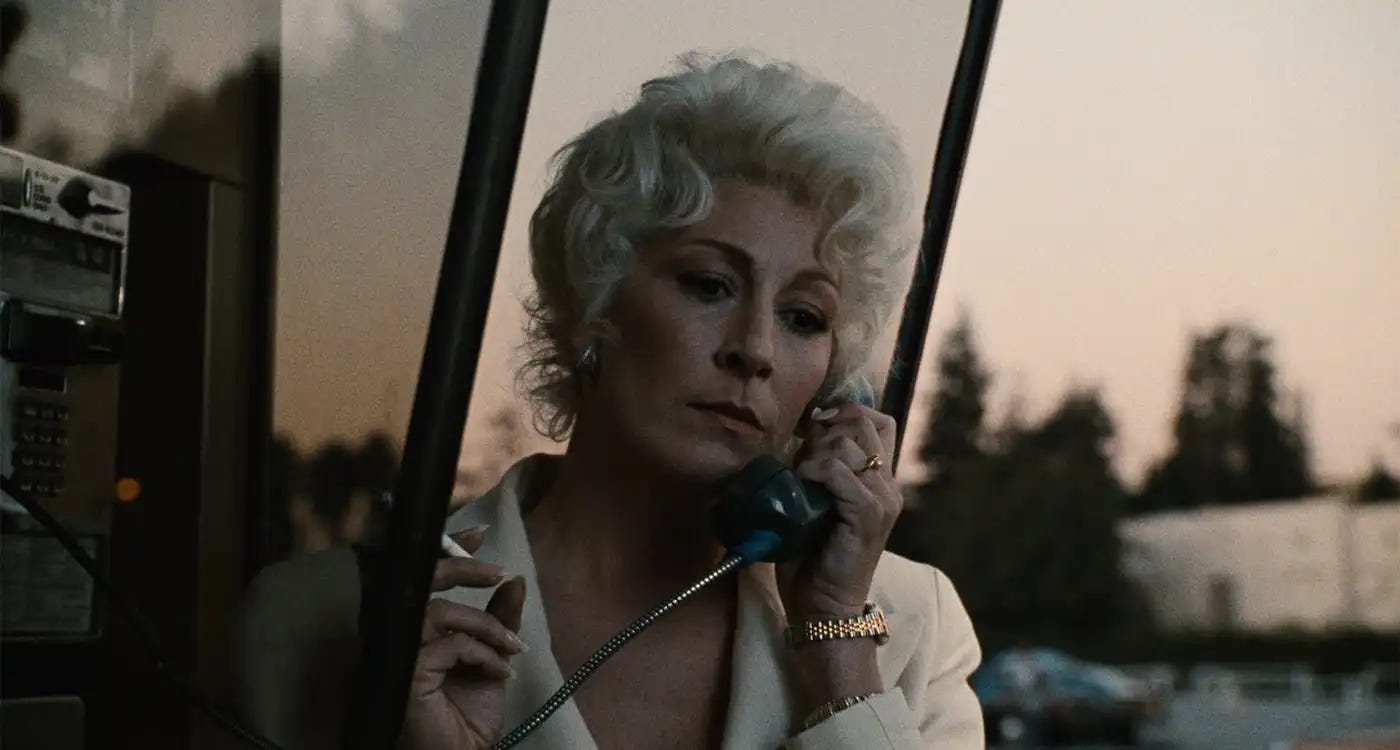
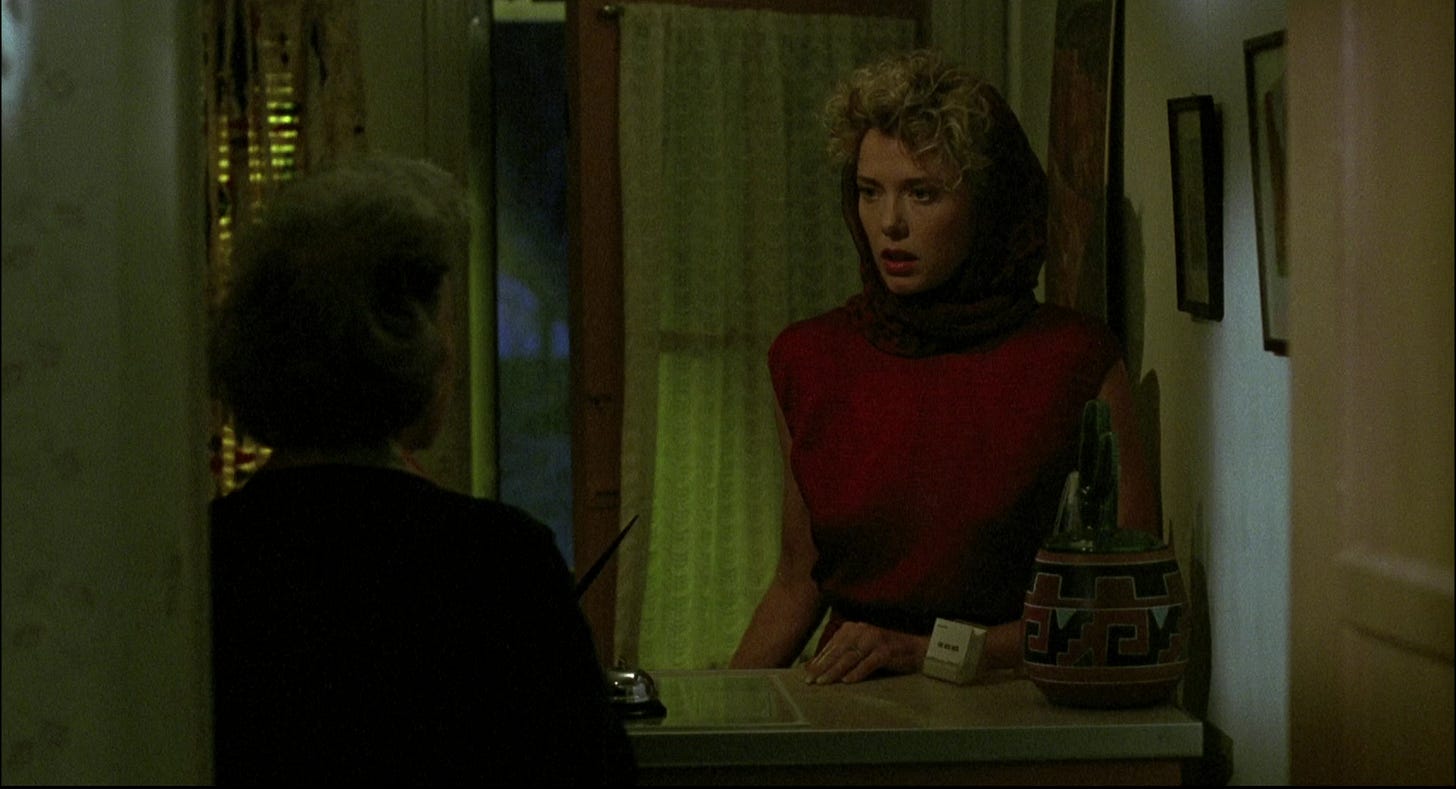
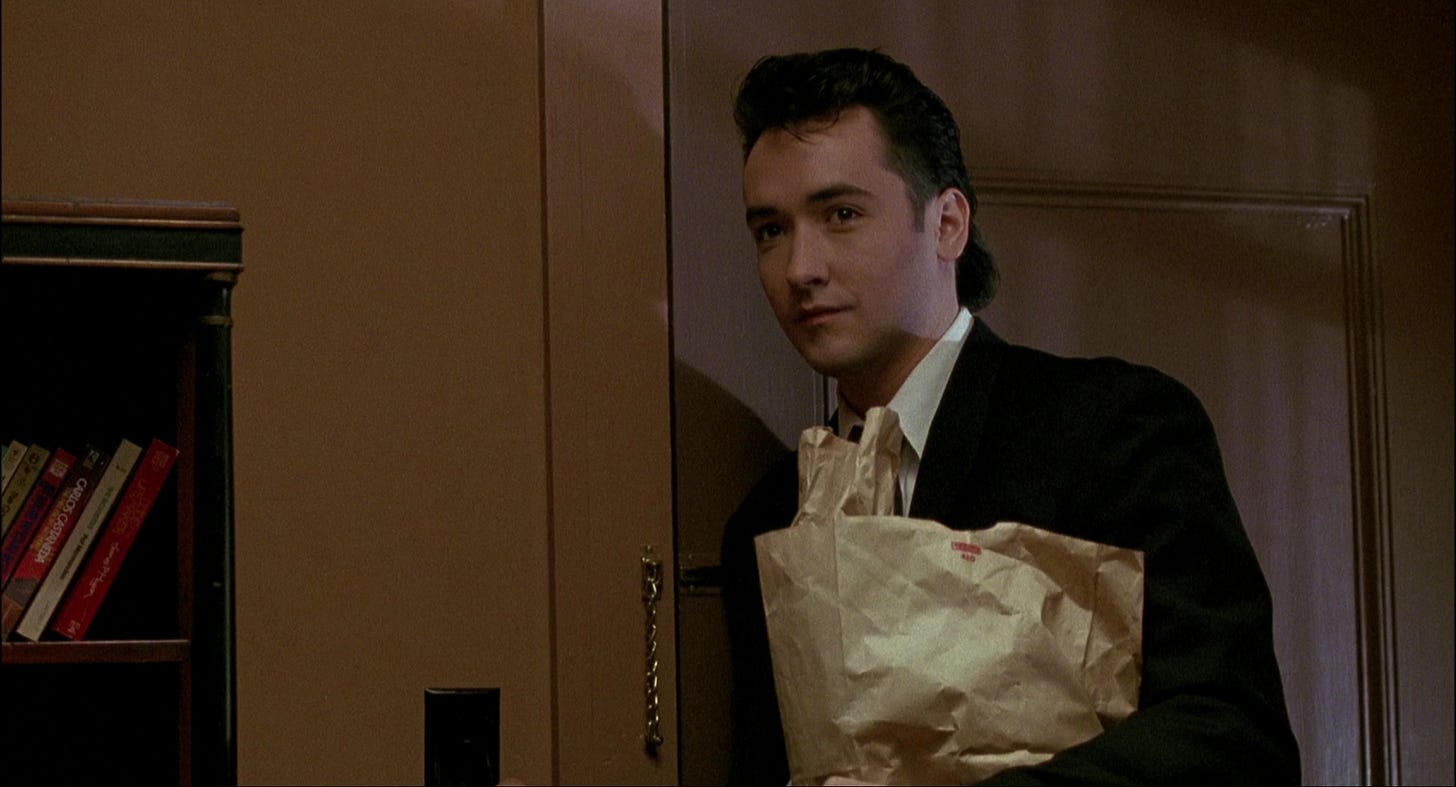
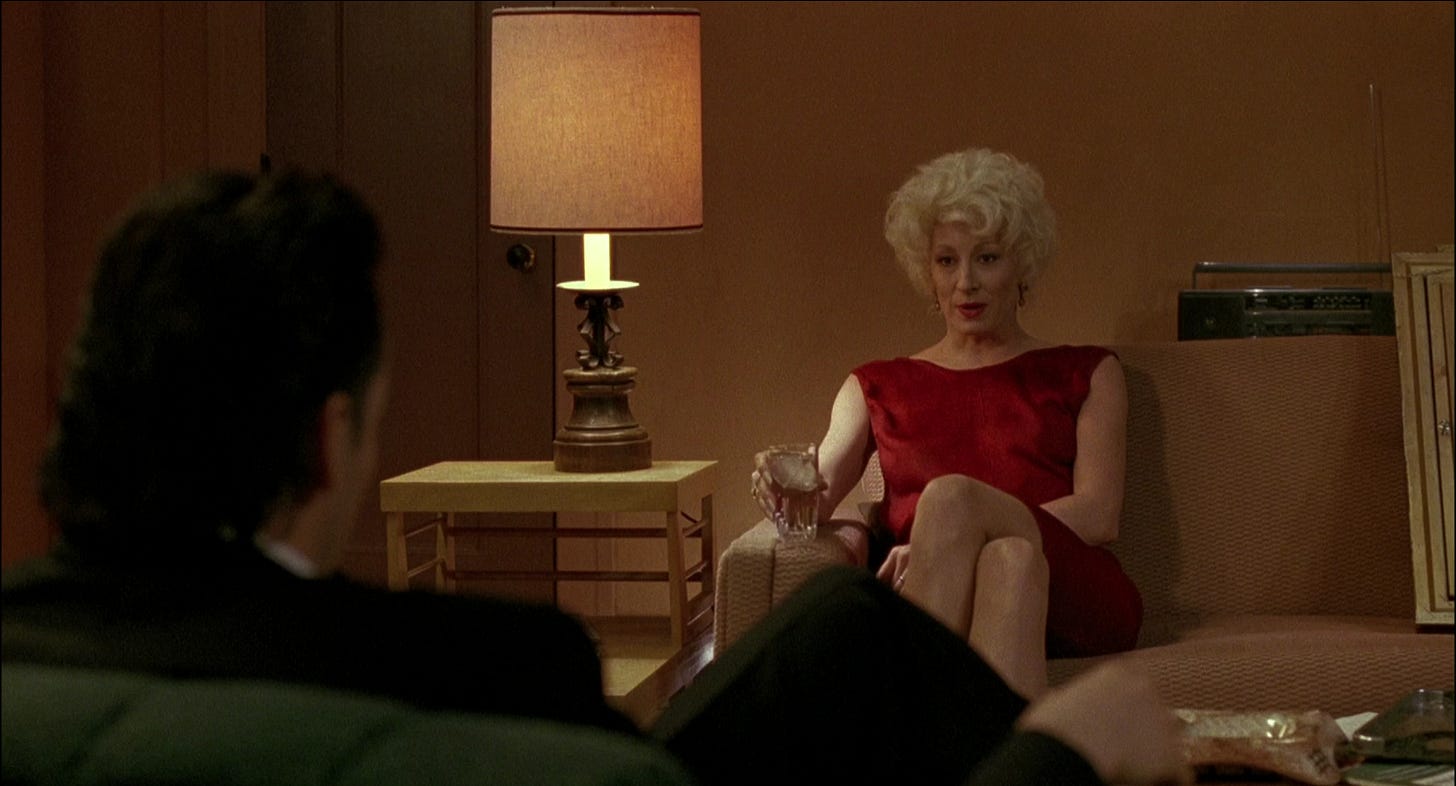

Sorry, Joe, never saw this movie… But as always, you make it so interesting that now I’m gonna look it up… Thank you, as always, great information and backstory! Peace! CPZ